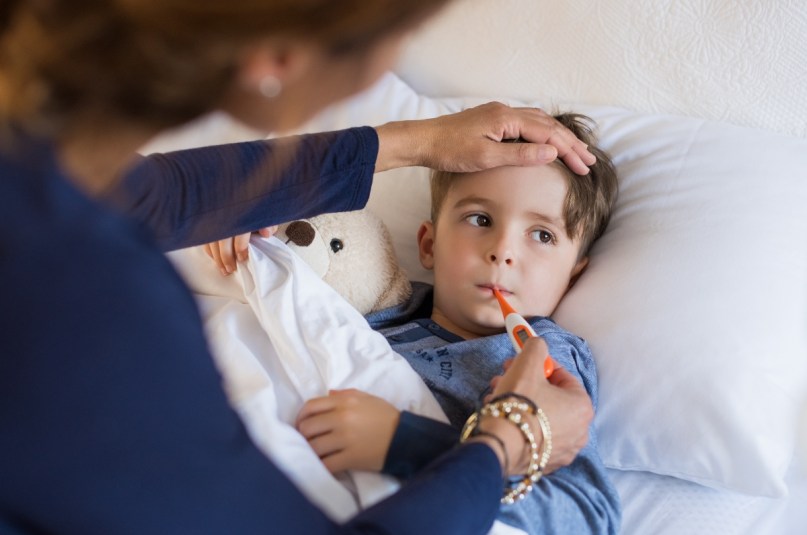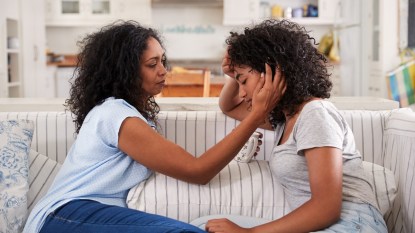Is a Doctor’s Visit or Bedrest Best for Your Sick Child? Symptoms and Recommendations for Common Kids’ Illnesses
Your sick-kid rescue plan.

Upset tummy? Runny nose? Sore throat? Between school, sports, and extracurriculars, your child is in near constant contact with other kids and their germs. Equipping them with preventative measures like washing their hands and keeping hands away from their mouth and eyes helps to ward off illness, but their immune systems are only so strong, and when they do get sick, it can be hard to know if they should visit the doctor of just stay home and rest. Here’s what to do when your child or grandchild is feeling under the weather — and when it’s time to bring in the pros.
Tummy Ache
Key symptoms: Constipation, diarrhea, stomach pain. A young baby may show these symptoms by crying, pulling up her legs, passing gas, vomiting or burping excessively.
Treatment
- For constipation: Drink small amounts of water or prune juice (under 6 months), or fruits and high fiber foods (over 6 months)
- For diarrhea: Most are caused by viral intestinal infections that don’t respond to medication. Probiotics may help mild diarrhea with vomiting. Use a pediatric electrolyte solution in place of normal diet. For significant diarrhea, withhold solid food and avoid liquids high in sugar. Offer a pediatric electrolyte solution.
Call a doctor if…
- Your child has severe abdominal pain lasting more than an hour or two, with nausea, vomiting, loss of appetite and fever (possibly appendicitis).
- Your baby has fewer wet diapers, no tears, or sunken eyes or fontanel (soft spot on head). These are signs of dehydration.
- Fever lasts longer than 24–48 hours
- There’s bloody stool
- Vomiting lasts longer than 12–24 hours and/or there’s green, blood-tinged or coffee-ground-looking vomit
- Abdomen feels hard, is swollen, or distended
- Child refuses to eat or drink and/or reports severe abdominal pain
- There is a rash or jaundice
- Your baby has excessive or bright-green spit up, it contains blood, they’re very uncomfortable or crying very hard, spitting up is forceful (shoots across room)
- Diarrhea contains blood or excessive mucus; child has more than eight stools per day
- Symptoms aren’t improving with time
Cuts and Scrapes
Key symptoms: Some bleeding, scraped, or lacerated skin
Treatment
- Rinse with cool water to flush away debris
- Wash gently with warm water and soap
- Use a butterfly bandage to help close the wound
- For large-oozing scrapes: Treat with an antibiotic ointment, cover with a sterile bandage or gauze
- For a deeper cut or laceration: Apply pressure with clean gauze or cloth for 5–10 minutes; try not to stop to peek at wound which would interrupt this pressure. Avoid using iodine
Call a doctor if…
- The cut or laceration is more than half an inch long or is deep
- You can’t get the wound clean, or you see pus, increased tenderness or redness around the site
- Fever develops
Cough
Key symptoms: Coughing, wheezing (often worse at night)
Treatment
- For children over age 6, pediatric cough medicine
- Extra fluids
- Cool-mist humidifier or vaporizer in room at night
Call a doctor if…
- Coughing makes it difficult for your child to breathe easily; is painful and persistent and is accompanied by whooping, vomiting or turning blue; interferes with eating and sleeping; appears suddenly with a high fever
Bug/Insect Bites or Stings
Key symptoms: Stinging sensation followed by small, red, itchy bumps or marks
Treatment
- For bites by mosquitoes, flies, fleas and bedbugs: Apply cool compress and calamine lotion or use a low-potency topical steroid. For children over age 6, an oral antihistamine (like Benadryl) can help control the itch
- For wasp or bee stings: Soak a cloth in cold water, press it over the area of the sting to reduce pain and swelling. Remove bee stinger quickly (gently scrape it off horizontally with a credit card or use a clean fingernail). Pediatric acetaminophen or ibuprofen (over 6 months) can reduce pain
Call a doctor if…
- Symptoms persist or become difficult to control
- If the bite looks like it has become infected (becomes redder, larger, more swollen)
- Call 911 if: Your child has sudden difficulty breathing, is weak, collapses or becomes unconscious, develops hives or itching all over body, vomits, has extreme swelling near eyes, lips, or penis that makes it difficult for child to see, eat or urinate
Bloody Nose
Key symptoms: Bleeding from nose
Treatment
- Have your child tilt his head slightly forward; gently blow nose
- Pinch lower half of child’s nose, hold firmly for 10 minutes
Call a doctor if…
- Your child is losing too much blood
- Bleeding is coming only from the mouth, or your child is coughing or vomiting blood or brown material
- Your child is pale and sweaty or unresponsive
Earache
Key symptoms: Pain in the ear (babies may cry during feedings or pull on ear), fever, sometimes pus or fluid, difficulty hearing, difficulty sleeping
Treatment
- Pediatric acetaminophen or ibuprofen (over 6 months)
- Place warm compress or heating pad on child’s ear (over 6 months)
Call a doctor if…
- You child has a high fever
- Symptoms last more than a day or two or worsen
Cold/Upper Respiratory Infection
Key symptoms: Runny nose, sneezing, mild fever (101–102 ̊F), reduced appetite, sore throat, cough, slightly swollen glands in neck
Treatment
- Use saline nose drops or spray for nasal congestion. For an infant, suction congestion with rubber suction bulb
- Use a cool-mist humidifier or vaporizer in room at night
- Give your child plenty of fluids
- Make sure your child gets lots of rest
- If your child is older than 6 months and has a fever, administer acetaminophen or ibuprofen (pediatric version)
Call a doctor if…
- Your baby is less than 3 months old: With a young infant, symptoms
can be misleading, and colds can quickly develop into more serious ailments, such as bronchitis, croup, or pneumonia - Lips or nails turn blue
- Nasal mucus lasts for more than 10–14 days
- Cough lasts more than a week
- There is ear pain, persistent fussiness or crying
- Temperature goes over 102 ̊F
Emergency Alert
Here’s when to take your child to the ER right away.
- Difficulty breathing
- Severe allergic reaction (shortness of breath, lip/oral swelling, persistent vomiting, altered mental status)
- High fever with headache and stiff neck
- Sudden difficulty in waking
- Sudden loss of sight, speech or movement
- Broken bone pushing through the skin
- Body part near an injured bone that is numb, tingling, weak, cold or pale
- Heavy bleeding or deep wound
- Serious burn
- Coughing or throwing up blood
- Fast heartbeat that doesn’t slow down
- Vomiting followed by dry mouth, not crying tears, no urination in more than eight hours or acting very sleepy/“out of it”
- Rectal temperature greater than 100.4 ̊F in children less than 2 months of age
When to Call 911
- Choking
- Severe difficulty breathing
- Head injury and unconsciousness
- Injury to neck or spine
- Child is not breathing or has turned blue
- Severe burn
- Seizure lasting more than five minutes
- Bleeding that can’t be stopped
A version of this article appeared in our partner magazine The Science of Raising Happy Kids.













